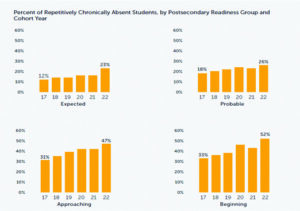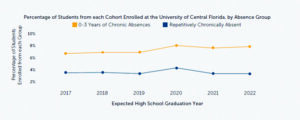Central Florida schools are experiencing an alarming surge in chronic absenteeism rates, particularly among Black and low-income students, posing a threat to their academic achievement and postsecondary readiness. However, there are recommended interventions to reverse this trend. The crucial findings come from a research report by Helios Education Foundation and the Central Florida Education Ecosystem Database (CFEED).
The data show that Black students experienced the biggest increase in chronic absenteeism from 2017 to 2022, reflecting a 67% jump. This is a very concerning trend, according to Dr. Paul Perrault, the Senior Vice President of Community Impact and Learning for Helios Education Foundation, who notes that before the COVID-19 pandemic, Black students previously had one of the lowest chronic absence rates in the area. “This is a troubling trend that, if left unaddressed, could severely impact underrepresented and low-income communities,” Perrault said.
To assess the extent of the issue, researchers analyzed 82,118 high school seniors from Osceola and Orange counties over five school years. The experts defined chronic absenteeism as missing 10 or more days of a school year. The data showed a disturbing correlation between persistent absences and low academic performance, particularly in accelerated courses. In 2017, approximately one-third of repetitively chronically absent high school seniors were deemed “not yet ready” for postsecondary coursework due to their poor performance. By 2022, this portion rose to nearly 50%

The impacts of repetitive absences move beyond high schools and into the universities in the region. The research shows that students with fewer absences enrolled at UCF at rates more than double those of students who were repeatedly chronically absent. Between 2017 and 2022, enrollment rates at UCF stood at nearly 8% for students with zero to three years of chronic absences, compared to almost 4% among students who had repetitive chronic absenteeism. Meanwhile, Valencia College found no differences in enrollment rates among chronically absent and repetitively chronically absent students.

Paul Luna, President and CEO of Helios Education Foundation, believes chronic absenteeism is not just a Central Florida issue but rather a national problem. “This is a problem we can’t afford to overlook,” he said. “We owe it to our students to ensure that they have every opportunity to thrive.”
In response to the concerning trend, Helios Education Foundation and CFEED have proposed three strategies to address the situation:
- Build awareness and understanding of chronic absenteeism, the challenges it presents, and its impacts.
- Establish practical, reliable systems to monitor attendance patterns and absenteeism trends, both annually and year-over-year.
- Celebrate and replicate school, grade, and classroom-level attendance successes.
As Central Florida schools grapple with the ramifications of increased chronic absenteeism, Helios leaders say it will take concerted efforts from students, parents, school leaders, and the community to mitigate its adverse effects on student success, particularly among Black students who are disproportionately impacted.






